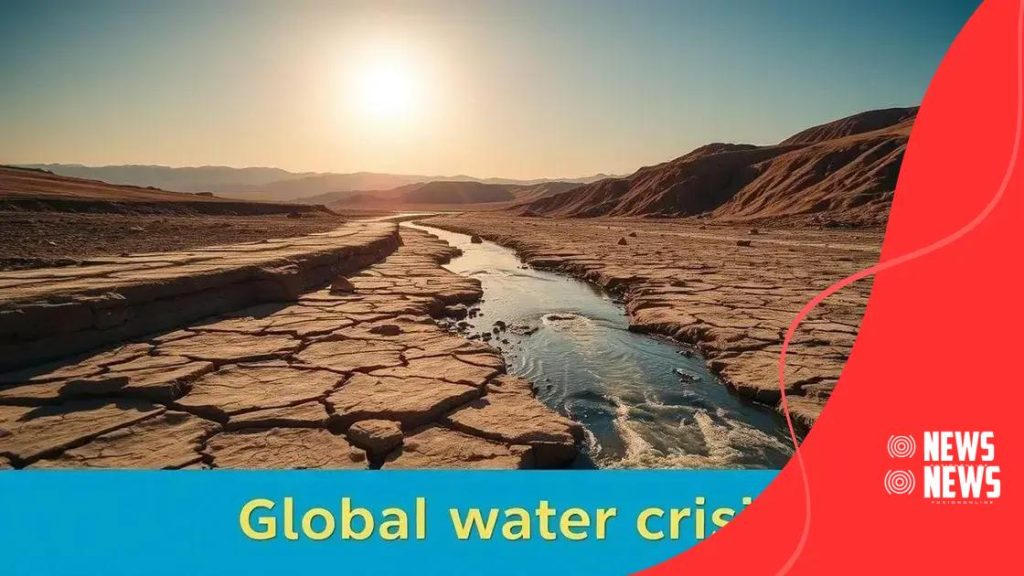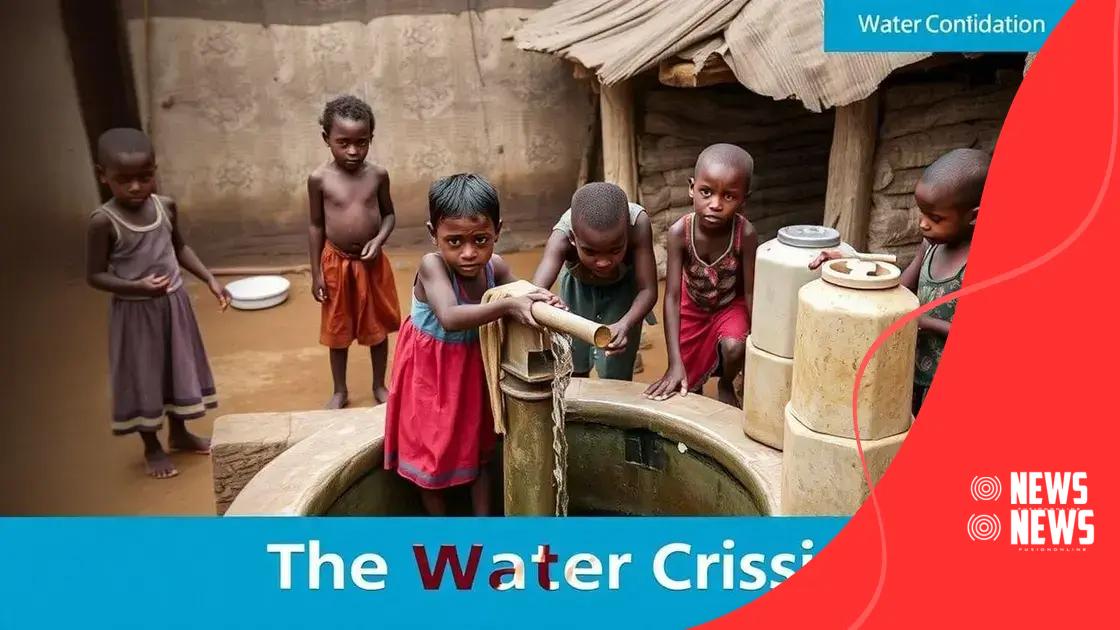Global water crisis: urgent challenges and innovative solutions

The global water crisis stems from climate change, population growth, and poor management practices, impacting health and driving the need for innovative solutions and effective policies to ensure sustainable water resources.
The global water crisis is a pressing issue affecting millions around the world. It invites us to reflect on our water consumption habits and consider sustainable practices to secure this precious resource for future generations. Are you aware of its implications in your local community?
Understanding the global water crisis
Understanding the global water crisis is essential for recognizing the challenges we face today. Water scarcity affects billions of people worldwide, leading to dire consequences. With the population growing, the demand for this vital resource increases.
Causes Behind Water Scarcity
Several factors lead to water scarcity. Climate change plays a significant role, causing irregular weather patterns and prolonged droughts. Urbanization also contributes as cities expand, putting pressure on local water supplies.
- Over-extraction of groundwater resources
- Poor water management practices
- Pollution affecting freshwater sources
- Increased demand from agriculture and industry
Another critical aspect is the relevance of pollution. Industrial waste and agricultural runoff contaminate rivers and lakes, making water unsafe for consumption. This contamination reduces the availability of clean water, compounding the crisis.
The Human Impact
The impact of the global water crisis affects various communities differently. Rural areas often face greater challenges in accessing clean water. Families may spend hours collecting water, which impacts education and health. Access to safe water is essential for sustainable development.
Reducing water wastage is crucial. Households can adopt simple measures, like fixing leaks and using water-saving fixtures. By practicing mindful consumption, each person can contribute to easing the pressure on water resources.
Education plays an essential role in addressing this crisis. By raising awareness about water conservation methods, communities can learn to use water more efficiently.
Major causes of water scarcity
There are several major causes contributing to water scarcity that impact millions globally. Understanding these causes can help us address this pressing issue effectively. Key factors include climate change, population growth, and inefficient water management.
Climate Change Effects
Climate change plays a crucial role in disrupting local weather patterns. With rising temperatures, regions experience severe droughts, affecting water availability. Rainfall becomes unpredictable, leading to reduced water supply during critical periods.
- Increased evaporation from lakes and rivers
- Changes in precipitation patterns
- More frequent and severe droughts
- Impact on agriculture and food production
Population growth also intensifies the demand for water. As communities expand, the need for drinking water, sanitation, and agricultural use rises significantly.
Inefficient Water Management
Inefficient water management practices further exacerbate the scarcity problem. Many countries struggle with outdated infrastructure that fails to deliver water effectively. Water loss due to leaks and wasteful agricultural practices are common issues.
Inadequate regulations and lack of awareness about conservation methods make it worse. Many people still do not realize how important it is to use water judiciously.
Impact of the water crisis on communities

The impact of the water crisis on communities is profound and far-reaching. It affects not only the daily lives of individuals but also the overall development of entire regions. Many families struggle to access clean and safe water, which leads to serious health issues.
Health Consequences
Without sufficient access to clean water, communities face increased health risks. Waterborne diseases thrive in areas where hygiene is compromised due to a lack of potable water.
- Cholera and diarrhea become common ailments.
- Children are especially vulnerable to dehydration.
- Malnutrition rates may rise due to the impact on food security.
- Increased healthcare costs strain local economies.
Furthermore, the pressure on existing water supplies can lead to conflicts within and between communities. As resources grow scarce, competition increases, often leading to social unrest.
Impact on Education
The water crisis also affects education, particularly for girls. In many regions, girls are responsible for collecting water, which consumes valuable time that could be spent in school. This results in lower attendance rates and educational attainment.
Access to clean water is crucial for creating a conducive learning environment. Schools without adequate water supply cannot promote proper sanitation practices, leading to higher absenteeism.
Economic development suffers as well. Businesses require reliable access to water for production processes. When communities cannot ensure water supply, it limits job creation and income-generating opportunities.
Innovative solutions to manage water resources
Innovative solutions to manage water resources are essential for addressing the ongoing crisis we face. Water scarcity is a growing challenge, and finding new ways to conserve and distribute water can make a significant difference. One effective method is the implementation of advanced technologies.
Technological Advances
New technologies can improve water efficiency in various sectors. For example, smart irrigation systems help farmers use less water while maintaining crop yields. These systems utilize sensors and weather data to deliver precise water amounts to plants.
- Drip irrigation reduces water waste.
- Rainwater harvesting systems capture and store rain for later use.
- Water recycling and treatment technologies allow communities to reuse wastewater.
- Mobile apps provide users with tips on conserving water.
Another innovative approach is building green infrastructure. This includes creating green roofs, permeable pavements, and rain gardens. Such infrastructures absorb rainwater, reducing run-off and allowing water to seep into the ground, replenishing groundwater supplies.
Community Engagement
In addition to technology, community involvement plays a crucial role in managing water resources. Engaging local people in water conservation can lead to more effective solutions. Educational programs promote awareness about water usage and encourage households to adopt water-saving practices.
Collaborating with local governments and organizations to establish policies that protect water rights is vital. Programs focusing on watershed management can ensure that communities maintain clean and available water supplies.
Finally, sustainable agriculture practices can significantly improve water management. Implementing crop rotation, conservation tillage, and organic farming techniques helps maintain soil health. Healthy soil absorbs more water, reducing irrigation needs and enhancing resilience to drought.
The role of policy in solving water issues
The role of policy in solving water issues is crucial for ensuring sustainable management of water resources. Effective policies can create frameworks for conservation, distribution, and equitable access to water. Governments and organizations need to collaborate to address the challenges posed by the global water crisis.
Regulations and Guidelines
Strong regulations help manage water use across various sectors. For instance, setting limits on water extraction for agriculture prevents overuse and ensures availability for future generations. These regulations can also promote innovation by incentivizing technologies that enhance water efficiency.
- Enforcing pollution control measures to protect water sources.
- Implementing restrictions on groundwater depletion.
- Encouraging water-saving technologies through subsidies.
- Establishing water quality standards to ensure public health.
Policy measures must also include assessments of water resources. This approach ensures that decision-makers understand the current state of water supplies, usage patterns, and the potential impact of climate change on regional resources.
Community Involvement and Education
Effective water policies involve the community in decision-making processes. Local input helps tailor strategies that meet specific regional needs. Educational programs raise awareness about the importance of water conservation and responsible usage, leading to cultural shifts in water management.
Policies should also promote transparency. Providing accessible information about water availability and quality empowers communities to engage in sustainable practices. When citizens understand water resources and their rights, they are more likely to participate in conservation efforts.
International cooperation plays a significant role as well. Many rivers cross national borders, requiring treaties and agreements to manage shared water resources. Collaborative efforts can lead to better resource allocation and conflict resolution among nations, promoting peace and stability.
FAQ – Frequently Asked Questions about the Global Water Crisis
What are the main causes of the global water crisis?
The main causes include climate change, population growth, and inefficient water management practices that lead to scarcity.
How does water scarcity impact health?
Water scarcity leads to increased health risks, such as waterborne diseases. Lack of clean water can also result in malnutrition and dehydration, especially among children.
What innovative solutions are being implemented to manage water resources?
Innovative solutions include smart irrigation systems, rainwater harvesting, and advanced water recycling technologies to enhance water efficiency.
What role does policy play in addressing water issues?
Policy plays a crucial role by establishing regulations for water use, promoting conservation strategies, and facilitating community involvement in water management.





